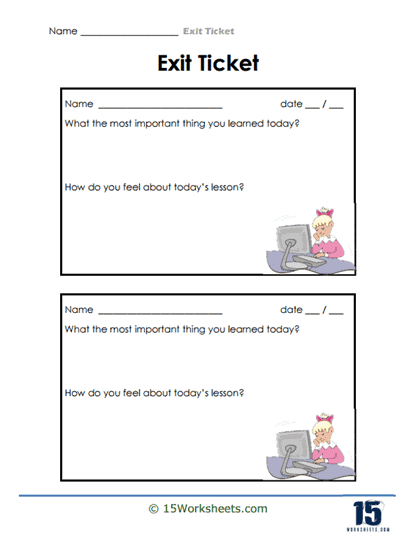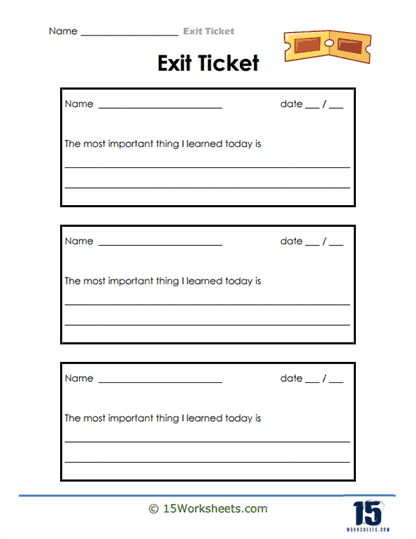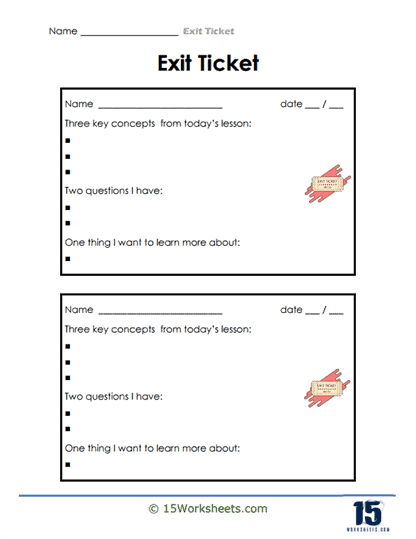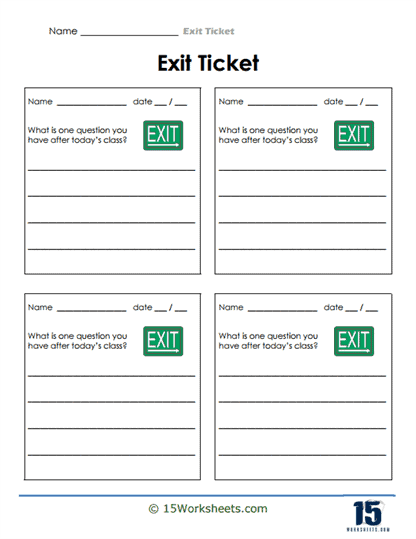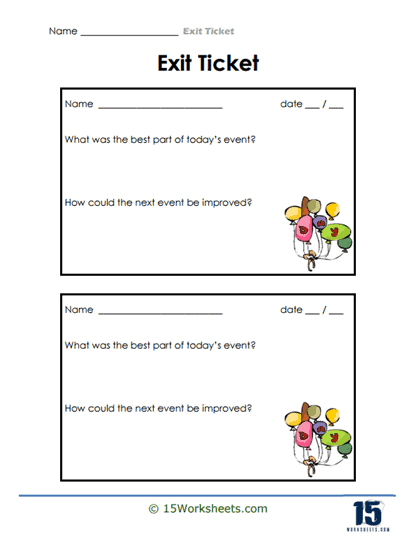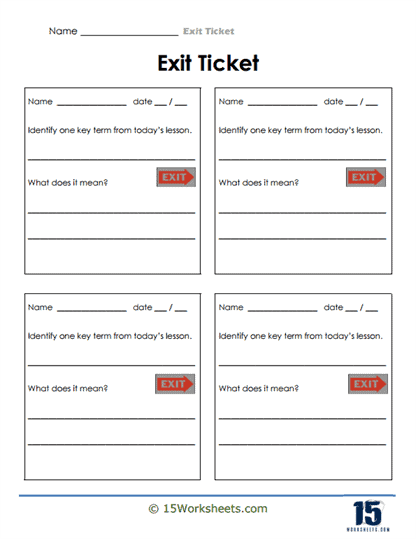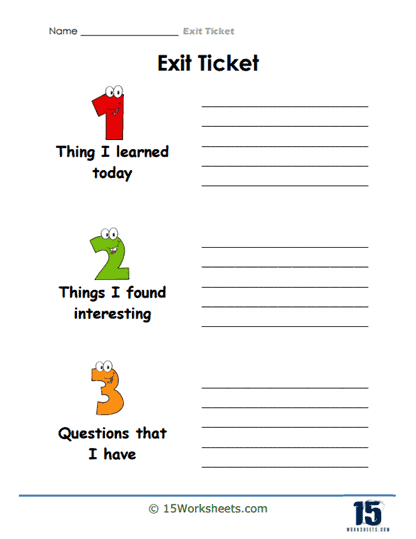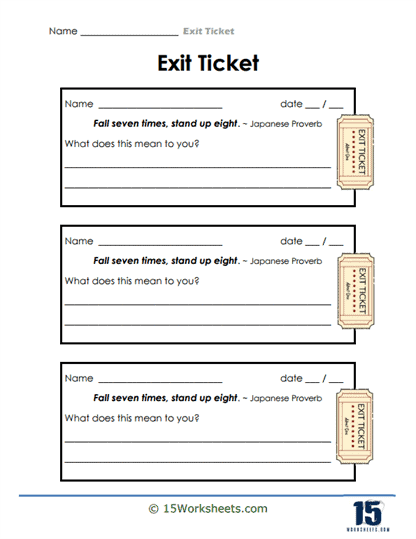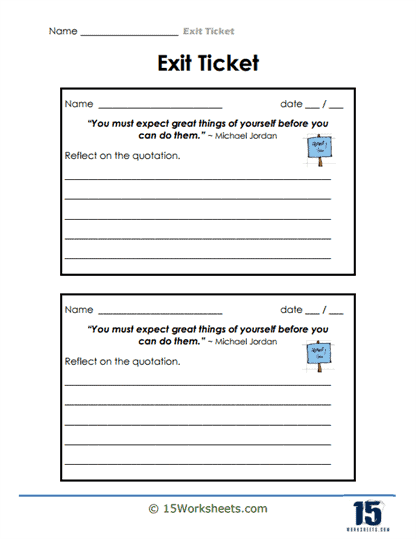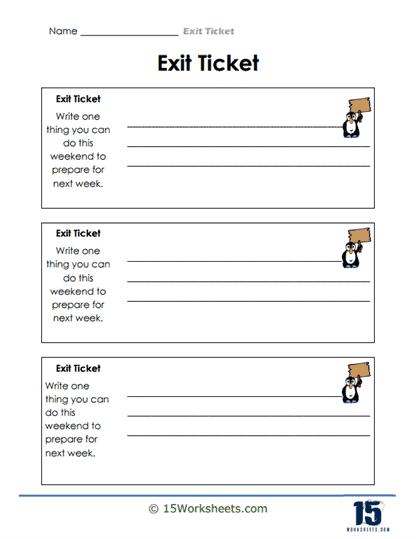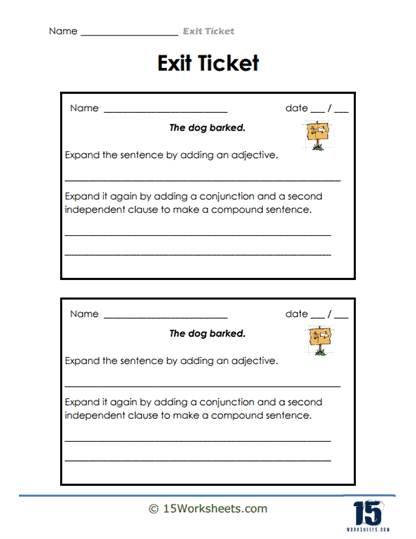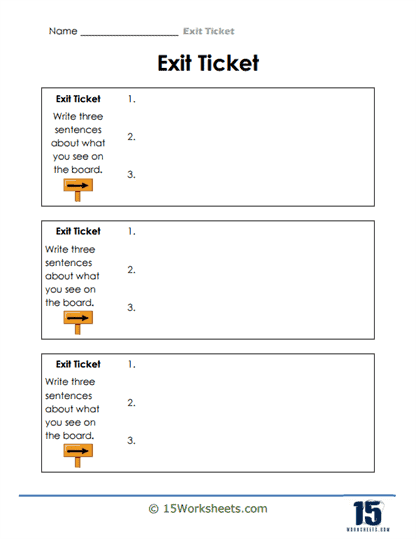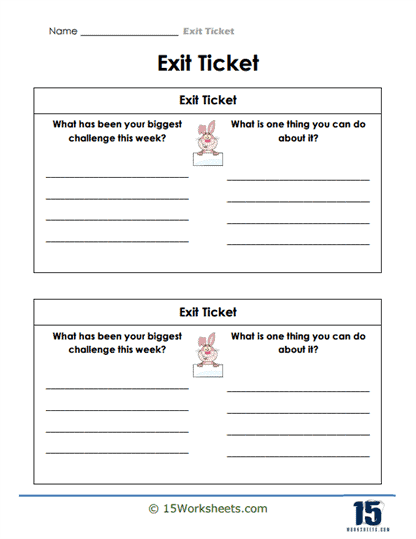Exit Tickets Worksheets
All About These 15 Worksheets
These worksheets are used by teachers, homeschoolers, and tutors to assess student understanding and engagement at the end of a lesson or class. These worksheets, designed for quick completion, provide a formative assessment that helps instructors gauge what students have learned, identify areas of confusion, and prepare for the next lesson. The worksheets typically take just a few minutes to complete and serve as a reflective exercise for students, while giving the teacher real-time insights into the effectiveness of their teaching. They can be used across various subjects and grade levels, making them highly versatile in different educational settings.
In the series of images provided, there are several different types of Exit Ticket exercises, each serving a distinct purpose:
Word Scramble and Vocabulary Review – These worksheets ask students to unscramble letters to form words, a fun and engaging way to review key vocabulary. The scrambled words often relate to important terms from the day’s lesson, which allows students to reinforce their understanding of subject-specific terminology and concepts. Additionally, unscrambling words strengthens spelling and word recognition, while encouraging critical thinking as students apply what they’ve learned in a new format. For example, unscrambling words like “symathypt” (sympathy) and “aceep” (peace) allows students to reflect on empathy-related terms, which also enhances comprehension of the lesson’s theme.
Reflection and Feedback on Learning – Several worksheets prompt students to reflect on their learning by asking questions such as “What was the most important thing you learned today?” or “How do you feel about today’s lesson?” This reflective process encourages students to pause and assess their own learning, fostering self-awareness about what they understand and what they may still be unclear about. For teachers, it serves as a crucial feedback mechanism to gauge how well the lesson objectives were met and to identify any gaps in student understanding or engagement.
Parts of Speech Exercises – Another category of Exit Ticket focuses on grammar, where students are given a word and must identify its part(s) of speech, such as noun, verb, adjective, etc. This helps solidify grammar rules by applying them in context and deepens students’ understanding of language structure. Additionally, the worksheet encourages vocabulary building by having students think of synonyms and antonyms, offering a richer grasp of word usage and meaning, while also helping teachers assess whether students can properly identify and apply different parts of speech.
Question Prompts – A recurring theme in Exit Tickets is asking students to generate their own questions based on the lesson, such as “What is one question you have after today’s class?” This exercise encourages critical thinking by prompting students to reflect on areas of the lesson that may still be unclear or spark curiosity. For teachers, these questions serve as a roadmap for future lessons, revealing where students may need further explanation or where their interests lie for deeper exploration.
Event Feedback – One of the worksheets focuses on gathering feedback about a special event, asking students to reflect on what was the best part of the event and how it could be improved. This exercise not only teaches students to evaluate experiences but also empowers them by giving them a voice in improving future events. It is particularly useful for reflecting on field trips, assemblies, or guest speakers, as it allows educators to assess what aspects were most meaningful or engaging for the students and what areas could be enhanced.
Interpretation of Quotes – Some Exit Tickets offer deeper, thought-provoking prompts. For instance, one of the worksheets features a Japanese proverb-“Fall seven times, stand up eight”-and asks students to reflect on its meaning. This type of activity fosters higher-level thinking and allows students to engage with philosophical or motivational ideas on a personal level. It encourages them to interpret, apply the quote to their own experiences, and think critically about resilience and perseverance.
Weekend Preparation or Goals – Another type of Exit Ticket asks students to reflect on what they can do to prepare for the following week or how they can apply what they’ve learned in future contexts. These exercises promote forward thinking and goal setting, encouraging students to take ownership of their learning. By reflecting on practical actions they can take over the weekend or in the coming week, students build habits of planning and personal responsibility, fostering lifelong learning skills.
Structured Reflection (Three-Part Reflection) – A simple and organized worksheet divides reflection into three components – one thing learned today, two things found interesting, and one question the student has. This structured approach ensures students review key aspects of their day’s learning while also making space for curiosity. It helps students prioritize information and encourages a habit of critical reflection, making it easier for teachers to pinpoint exactly what resonated with students and what questions remain.
Sentence Expansion and Writing – Some Exit Ticket worksheets focus on writing skills by asking students to expand simple sentences by adding adjectives, conjunctions, or independent clauses to create more complex, varied sentences. This type of activity helps students develop their writing skills, teaching them to create richer, more descriptive sentences. It also encourages creativity and reinforces the mechanics of sentence structure, which is particularly beneficial in language arts classes as students learn to vary sentence types and express more nuanced ideas.
Observation Writing – Lastly, another type of worksheet asks students to write sentences based on what they observe, which can be a great exercise for subjects like science or art where observation skills are key. This activity develops students’ ability to describe their environment or a specific object in detail, fostering careful attention and descriptive language. It also provides teachers with insight into how well students are applying observational skills and translating them into clear, coherent writing.
What Are Exit Tickets?
Exit tickets are short, informal assessments given to students at the end of a lesson or class period. Typically, they consist of one or two questions that focus on the key concepts just taught. These can take various formats, including multiple-choice questions, short answer responses, or even reflections where students write what they learned or found challenging. They are often designed to be completed in just a few minutes, providing teachers with a snapshot of student comprehension before they leave the classroom. This approach helps teachers gather immediate feedback on the lesson’s effectiveness and students’ understanding.
One of the most significant benefits of exit tickets is that they give teachers real-time insights into student learning. By reviewing these quick assessments, teachers can immediately identify which concepts were well understood and which might require more review. This enables educators to adjust their lesson plans for the next class, either by reteaching certain topics or moving on to new material with more confidence. It also helps in differentiating instruction, as teachers can address specific needs of individual students who may need extra support.
For students, they serve as a low-pressure way to engage with and reflect on the material they’ve just learned. Since they are brief and typically focus on a specific part of the lesson, Exit Tickets give students an opportunity to consolidate their understanding in real-time. The quick format encourages even reluctant learners to participate without the pressure of a formal test. Moreover, by reflecting on their learning, students become more aware of what they have grasped and where they might need further clarification.
Exit Tickets also foster a more responsive and dynamic classroom environment. Since the feedback from these assessments is immediate, teachers can quickly close knowledge gaps before they become bigger issues. In turn, students feel more supported because their challenges are addressed in a timely manner. This responsiveness helps to create a classroom culture where learning is a continuous process, and mistakes or misunderstandings are seen as opportunities for growth rather than as failures.


